Concentrated solar power
.jpg)
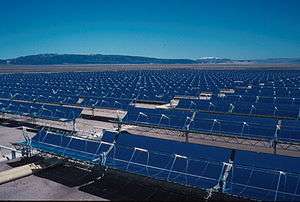
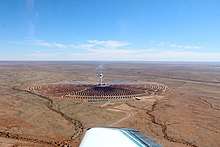
Concentrated solar power (also called concentrating solar power, concentrated solar thermal, and CSP) systems generate solar power by using mirrors or lenses to concentrate a large area of sunlight, or solar thermal energy, onto a small area. Electricity is generated when the concentrated light is converted to heat, which drives a heat engine (usually a steam turbine) connected to an electrical power generator[1][2][3] or powers a thermochemical reaction (experimental as of 2013).[4][5][6]
CSP had a world's total installed capacity of 4,815 MW in 2016, up from 354 MW in 2005. As of 2017, Spain accounted for almost half of the world's capacity, at 2,300 MW, making this country the world leader in CSP. The United States follows with 1,740 MW. Interest is also notable in North Africa and the Middle East, as well as India and China. The global market has been dominated by parabolic-trough plants, which accounted for 90% of CSP plants at one point.[7] The largest CSP projects in the world are the Ivanpah Solar Power Facility (392 MW) in the United States (which uses solar power tower technology) and the Mojave Solar Project (354 MW) in the United States (which uses parabolic troughs).
In most cases, CSP technologies currently cannot compete on price with photovoltaic solar panels, which have experienced huge growth in recent years due to falling prices and much smaller operating costs.[8][9] CSP generally needs large amount of direct solar radiation, and its energy generation falls dramatically with cloud cover. This is in contrast with photovoltaics, which can produce electricity also from diffuse radiation.[10]
However, the advantage of CSP over PV is that as a thermal technology, running a conventional thermal power block, a CSP plant can store the heat of solar energy in molten salts, which enables these plants to continue to generate electricity whenever it is needed, whether day or night. This makes CSP a dispatchable form of solar. This is particularly valuable in places where there is already a high penetration of PV, such as California[11] because an evening peak is being exacerbated as PV ramps down at sunset.
CSP has other uses than electricity. Researchers are increasingly investigating solar thermal reactors for the production of solar fuels, making solar a fully transportable form of energy in the future. These researchers use the solar heat of CSP as a catalyst for thermochemistry to break apart molecules of H2O, to create hydrogen (H2) from solar energy with no carbon emissions. [12] By splitting both H2O and CO2, other much-used hydrocarbons for example, the jet fuel used to fly commercial airplanes, could also be created with solar energy rather than from fossil fuels.[13]
In 2017, CSP represented less than 2% of worldwide installed capacity of solar electricity plants.[14] However, in recent years falling prices of CSP plants are making this technology competitive with other base-load power plants using fossil and nuclear fuel even in high moisture and dusty atmosphere at sea level, such as the United Arab Emirates.[15][16] Base-load CSP tariff in the extremely dry Atacama region of Chile reached below ¢5.0/kWh in 2017 auctions.[17][18]
History

A legend has it that Archimedes used a "burning glass" to concentrate sunlight on the invading Roman fleet and repel them from Syracuse. In 1973 a Greek scientist, Dr. Ioannis Sakkas, curious about whether Archimedes could really have destroyed the Roman fleet in 212 BC, lined up nearly 60 Greek sailors, each holding an oblong mirror tipped to catch the sun's rays and direct them at a tar-covered plywood silhouette 49 m (160 ft) away. The ship caught fire after a few minutes; however, historians continue to doubt the Archimedes story.[19]
In 1866, Auguste Mouchout used a parabolic trough to producе steam for the first solar steam engine. The first patent for a solar collector was obtained by the Italian Alessandro Battaglia in Genoa, Italy, in 1886. Over the following years, invеntors such as John Ericsson and Frank Shuman developed concentrating solar-powered dеvices for irrigation, refrigеration, and locomоtion. In 1913 Shuman finished a 55 HP parabolic solar thermal energy station in Maadi, Egypt for irrigation.[20][21][22][23] The first solar-power system using a mirror dish was built by Dr. R.H. Goddard, who was already well known for his research on liquid-fueled rockets and wrote an article in 1929 in which he asserted that all the previous obstacles had been addressed.[24]
Professor Giovanni Francia (1911–1980) designed and built the first concentrated-solar plant, which entered into operation in Sant'Ilario, near Genoa, Italy in 1968. This plant had the architecture of today's power tower plants with a solar receiver in the center of a field of solar collectors. The plant was able to produce 1 MW with superheated steam at 100 bar and 500 °C.[25] The 10 MW Solar One power tower was developed in Southern California in 1981. Solar One, was converted Solar Two in 1995, using molten salt as the receiver working fluid and as a storage medium until it was decommissioned in 1999. The parabolic-trough technology of the nearby Solar Energy Generating Systems (SEGS), begun in 1984, was more workable. The 354 MW SEGS was the largest solar power plant in the world, until 2014.
No commercial concentrated solar was constructed from 1990 when SEGS was completed until 2006 when the Compact linear Fresnel reflector system at Liddell Power Station in Australia was built. Few other plants were built with this design although the 5 MW Kimberlina Solar Thermal Energy Plant opened in 2009.
In 2007, 75MW Nevada Solar One was built, a trough design and the first large plant since SEGS. Between 2009 and 2013, Spain built over 40 parabolic trough systems, standardized in 50MW blocks.
Due to the success of Solar Two, a commercial power plant, called Solar Tres Power Tower, was built in Spain in 2011, later renamed Gemasolar Thermosolar Plant. Gemasolar's results paved the way for further plants of its type. Ivanpah Solar Power Facility was constructed at the same time but without thermal storage, using natural gas to preheat water each morning.
Most concentrated solar power plants use the parabolic trough design, instead of the power tower or Fresnel systems. There have also been variations of parabolic trough systems like the integrated solar combined cycle (ISCC) which combines troughs and conventional fossil fuel heat systems.
CSP was originally treated as a competitor to photovoltaics, and Ivanpah was built without energy storage, although Solar Two had included several hours of thermal storage. By 2015, prices for photovoltaic plants had fallen and PV commercial power was selling for 1⁄3 of recent CSP contracts.[26][27] However, increasingly, CSP was being bid with 3 to 12 hours of thermal energy storage, making CSP a dispatchable form of solar energy.[28] As such, it is increasingly seen as competing with natural gas and PV with batteries for flexible, dispatchable power.
Current technology
CSP is used to produce electricity (sometimes called solar thermoelectricity, usually generated through steam). Concentrated-solar technology systems use mirrors or lenses with tracking systems to focus a large area of sunlight onto a small area. The concentrated light is then used as heat or as a heat source for a conventional power plant (solar thermoelectricity). The solar concentrators used in CSP systems can often also be used to provide industrial process heating or cooling, such as in solar air conditioning.
Concentrating technologies exist in four optical types, namely parabolic trough, dish, concentrating linear Fresnel reflector, and solar power tower.[29] Parabolic trough and concentrating linear Fresnel reflectors are classified as linear focus collector types. Dish and solar tower as of the point focus type. Linear focus collectors achieve medium concentration (50 suns and over), and point focus collectors achieve high concentration (over 500 suns) factors. Although simple, these solar concentrators are quite far from the theoretical maximum concentration.[30][31] For example, the parabolic-trough concentration gives about 1⁄3 of the theoretical maximum for the design acceptance angle, that is, for the same overall tolerances for the system. Approaching the theoretical maximum may be achieved by using more elaborate concentrators based on nonimaging optics.[30][31][32]
Different types of concentrators produce different peak temperatures and correspondingly varying thermodynamic efficiencies, due to differences in the way that they track the sun and focus light. New innovations in CSP technology are leading systems to become more and more cost-effective.[33][34]
Parabolic trough
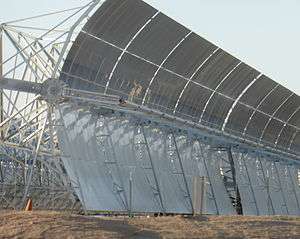
A parabolic trough consists of a linear parabolic reflector that concentrates light onto a receiver positioned along the reflector's focal line. The receiver is a tube positioned directly above the middle of the parabolic mirror and filled with a working fluid. The reflector follows the sun during the daylight hours by tracking along a single axis. A working fluid (e.g. molten salt[35]) is heated to 150–350 °C (302–662 °F) as it flows through the receiver and is then used as a heat source for a power generation system.[36] Trough systems are the most developed CSP technology. The Solar Energy Generating Systems (SEGS) plants in California, the world's first commercial parabolic trough plants, Acciona's Nevada Solar One near Boulder City, Nevada, and Andasol, Europe's first commercial parabolic trough plant are representative, along with Plataforma Solar de Almería's SSPS-DCS test facilities in Spain.[37]
Solar power tower
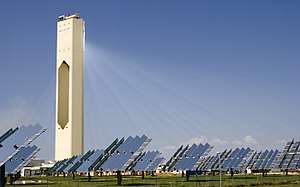
A solar power tower consists of an array of dual-axis tracking reflectors (heliostats) that concentrate sunlight on a central receiver atop a tower; the receiver contains a heat-transfer fluid, which can consist of water-steam or molten salt. Optically a solar power tower is the same as a circular Fresnel reflector. The working fluid in the receiver is heated to 500–1000 °C (773–1,273 K or 932–1,832 °F) and then used as a heat source for a power generation or energy storage system.[36] An advantage of the solar tower is the reflectors can be adjusted instead of the whole tower. Power-tower development is less advanced than trough systems, but they offer higher efficiency and better energy storage capability.
The Solar Two in Daggett, California and the CESA-1 in Plataforma Solar de Almeria Almeria, Spain, are the most representative demonstration plants. The Planta Solar 10 (PS10) in Sanlucar la Mayor, Spain, is the first commercial utility-scale solar power tower in the world. The 377 MW Ivanpah Solar Power Facility, located in the Mojave Desert, is the largest CSP facility in the world, and uses three power towers.[38] Ivanpah generated only 0.652 TWh (63%) of its energy from solar means, and the other 0.388 TWh (37%) was generated by burning Natural Gas. [39][40][41]
Enclosed trough
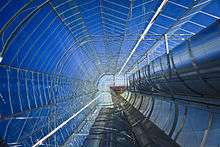
The design encapsulates the solar thermal system within a greenhouse-like glasshouse. The glasshouse creates a protected environment to withstand the elements that can negatively impact reliability and efficiency of the solar thermal system.[42] Lightweight curved solar-reflecting mirrors are suspended from the ceiling of the glasshouse by wires. A single-axis tracking system positions the mirrors to retrieve the optimal amount of sunlight. The mirrors concentrate the sunlight and focus it on a network of stationary steel pipes, also suspended from the glasshouse structure.[43] Water is carried throughout the length of the pipe, which is boiled to generate steam when intense solar radiation is applied. Sheltering the mirrors from the wind allows them to achieve higher temperature rates and prevents dust from building up on the mirrors.[42]
GlassPoint Solar, the company that created the Enclosed Trough design, states its technology can produce heat for Enhanced Oil Recovery (EOR) for about $5 per million British thermal units in sunny regions, compared to between $10 and $12 for other conventional solar thermal technologies.[44]
Fresnel reflectors
Fresnel reflectors are made of many thin, flat mirror strips to concentrate sunlight onto tubes through which working fluid is pumped. Flat mirrors allow more reflective surface in the same amount of space than a parabolic reflector, thus capturing more of the available sunlight, and they are much cheaper than parabolic reflectors. Fresnel reflectors can be used in various size CSPs.[45][46]
Fresnel reflectors are sometimes regarded as a technology with a worse output than other methods. The cost efficiency of this model is what causes some to use this instead of others with higher output ratings. Some new models of Fresnel Reflectors with Ray Tracing capabilities have begun to be tested and have initially proved to yield higher output than the standard version.[47]
Dish Stirling
A dish Stirling or dish engine system consists of a stand-alone parabolic reflector that concentrates light onto a receiver positioned at the reflector's focal point. The reflector tracks the Sun along two axes. The working fluid in the receiver is heated to 250–700 °C (482–1,292 °F) and then used by a Stirling engine to generate power.[36] Parabolic-dish systems provide high solar-to-electric efficiency (between 31% and 32%), and their modular nature provides scalability. The Stirling Energy Systems (SES), United Sun Systems (USS) and Science Applications International Corporation (SAIC) dishes at UNLV, and Australian National University's Big Dish in Canberra, Australia are representative of this technology. A world record for solar to electric efficiency was set at 31.25% by SES dishes at the National Solar Thermal Test Facility (NSTTF) in New Mexico on 31 January 2008, a cold, bright day.[48] According to its developer, Ripasso Energy, a Swedish firm, in 2015 its Dish Sterling system being tested in the Kalahari Desert in South Africa showed 34% efficiency.[49] The SES installation in Maricopa, Phoenix was the largest Stirling Dish power installation in the world until it was sold to United Sun Systems. Subsequently, larger parts of the installation have been moved to China as part of the huge energy demand.
Solar thermal enhanced oil recovery
Heat from the sun can be used to provide steam used to make heavy oil less viscous and easier to pump. Solar power tower and parabolic troughs can be used to provide the steam which is used directly so no generators are required and no electricity is produced. Solar thermal enhanced oil recovery can extend the life of oilfields with very thick oil which would not otherwise be economical to pump.[50]
CSP with thermal energy storage
In a CSP plant that includes storage, the solar energy is first used to heat the molten salt or synthetic oil which is stored providing thermal/heat energy at high temperature in insulated tanks.[51][52] Later the hot molten salt (or oil) is used in a steam generator to produce steam to generate electricity by steam turbo generator as per requirement.[53] Thus solar energy which is available in daylight only is used to generate electricity round the clock on demand as a Load following power plant or solar peaker plant.[54][55] The thermal storage capacity is indicated in hours of power generation at nameplate capacity. Unlike solar PV or CSP without storage, the power generation from solar thermal storage plants is dispatchable and self-sustainable similar to coal/gas-fired power plants, but without the pollution.[56]
Deployment around the world
| Country | Total | Added |
|---|---|---|
| 2,300 | 0 | |
| 1,738 | 0 | |
| 300 | 100 | |
| 225 | 0 | |
| 180 | 0 | |
| 100 | 0 | |
| 25 | 0 | |
| 20 | 0 | |
| 12 | 0 | |
| 10 | 0 | |
| 5 | 0 | |
| Source: REN21 Global Status Report, 2017 and 2018[57][58] | ||
The commercial deployment of CSP plants started by 1984 in the US with the SEGS plants. The last SEGS plant was completed in 1990. From 1991 to 2005, no CSP plants were built anywhere in the world. Global installed CSP-capacity increased nearly tenfold between 2004 and 2013 and grew at an average of 50 percent per year during the last five of those years.[59]:51 In 2013, worldwide installed capacity increased by 36% or nearly 0.9 gigawatt (GW) to more than 3.4 GW. Spain and the United States remained the global leaders, while the number of countries with installed CSP were growing but the rapid decrease in price of PV solar, policy changes and the global financial crisis stopped most development in these countries. 2014 was the best year for CSP but was followed by a rapid decline with only one major plant completed in the world in 2016. There is a notable trend towards developing countries and regions with high solar radiation with several large plants under construction in 2017.
CSP is also increasingly competing with the cheaper photovoltaic solar power and with concentrator photovoltaics (CPV), a fast-growing technology that just like CSP is suited best for regions of high solar insolation.[60][61] In addition, a novel solar CPV/CSP hybrid system has been proposed recently.[62]
| Year | 1984 | 1985 | 1989 | 1990 | 1991-2005 | 2006 | 2007 | 2008 | 2009 | 2010 | 2011 | 2012 | 2013 | 2014 | 2015 | 2016 | 2017 |
|---|---|---|---|---|---|---|---|---|---|---|---|---|---|---|---|---|---|
| Installed | 14 | 60 | 200 | 80 | 0 | 1 | 74 | 55 | 179 | 307 | 629 | 803 | 872 | 925 | 420 | 110 | 100 |
| Cumulative | 14 | 74 | 274 | 354 | 354 | 355 | 429 | 484 | 663 | 969 | 1,598 | 2,553 | 3,425 | 4,335 | 4,705 | 4,815 | 4,915 |
| Sources: REN21[57][63]:146 [59] :51 [58] · CSP-world.com[64] · IRENA[65] | |||||||||||||||||
Efficiency
The conversion efficiency of the incident solar radiation into mechanical work − without considering the ultimate conversion step into electricity by a power generator − depends on the thermal radiation properties of the solar receiver and on the heat engine (e.g. steam turbine). Solar irradiation is first converted into heat by the solar receiver with the efficiency and subsequently the heat is converted into work by the heat engine with the efficiency , using Carnot's principle.[66][67] For a solar receiver providing a heat source at temperature and a heat sink at room temperature , the overall conversion efficiency can be calculated as follows:
- with
- and
- It should also be noted that the Carnot efficiencies of typical engines achieve only about 70% of this efficiency due to losses such as heat loss and windage in the moving parts.
- where , , are respectively the incoming solar flux and the fluxes absorbed and lost by the system solar receiver.
For a solar flux (e.g. ) concentrated times with an efficiency on the system solar receiver with a collecting area and an absorptivity :
- ,
- ,
For simplicity's sake, one can assume that the losses are only radiative ones (a fair assumption for high temperatures), thus for a reradiating area A and an emissivity applying the Stefan-Boltzmann law yields:
Simplifying these equations by considering perfect optics ( = 1), collecting and reradiating areas equal and maximum absorptivity and emissivity ( = 1, = 1) then substituting in the first equation gives
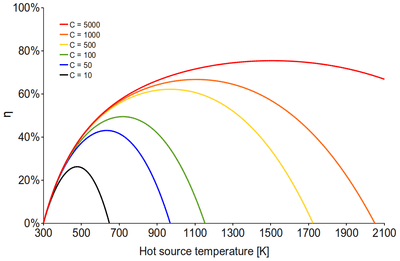
The graph shows that the overall efficiency does not increase steadily with the receiver's temperature. Although the heat engine's efficiency (Carnot) increases with higher temperature, the receiver's efficiency does not. On the contrary, the receiver's efficiency is decreasing, as the amount of energy it cannot absorb (Qlost) grows by the fourth power as a function of temperature. Hence, there is a maximum reachable temperature. When the receiver efficiency is null (blue curve on the figure below), Tmax is:
There is a temperature Topt for which the efficiency is maximum, i.e. when the efficiency derivative relative to the receiver temperature is null:
Consequently, this leads us to the following equation:
Solving this equation numerically allows us to obtain the optimum process temperature according to the solar concentration ratio (red curve on the figure below)
| C | 500 | 1000 | 5000 | 10000 | 45000 (max. for Earth) |
|---|---|---|---|---|---|
| Tmax | 1720 | 2050 | 3060 | 3640 | 5300 |
| Topt | 970 | 1100 | 1500 | 1720 | 2310 |
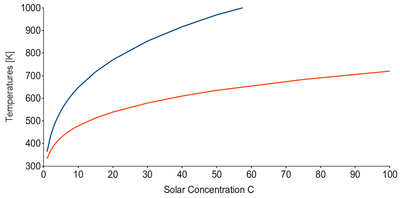
Theoretical efficiencies aside, real-world experience of CSP reveals a 25%–60% shortfall in projected production, a good part of which is due to the practical Carnot cycle losses not included in the above analysis.
Costs
As of 2017, new CSP power plants are economically competitive with fossil fuels in certain regions, such as Chile, Australia,[68] and the Middle east and North Africa Region (MENA).[69] Nathaniel Bullard, a solar analyst at Bloomberg New Energy Finance, calculated that the cost of electricity at the Ivanpah Solar Power Facility, a project contracted in 2009 and completed in 2014 in Southern California, would be lower than that from photovoltaic power and about the same as that from natural gas.[70] However, due to the rapid price decline of photovoltaics, in November 2011, Google announced that they would not invest further in CSP projects Google had invested US$168 million on BrightSource.[71][72] IRENA has published in June 2012 a series of studies titled: "Renewable Energy Cost Analysis". The CSP study shows the cost of both building and operation of CSP plants. Costs are expected to decrease, but there are insufficient installations to clearly establish the learning curve.
By 2012, there was 1.9 GW of CSP installed, with 1.8 GW of that being parabolic trough.[73] The US Department of Energy publishes the up to date list of CSP power plants at the National Renewable Energy Laboratory (NREL) under a contract from SolarPACES, the international network of CSP researchers and industry experts. As of 2017, there is 5 GW of CSP installed globally, with most of that in Spain at 2.3 GW, and the US at 1.3 GW.
At the 2016 Chile auction, SolarReserve bid $63/MWh (¢6.3/kWh) for 24-hour CSP power with no subsidies, competing with other types such as LNG gas turbines.[18] In 2017, prices for both bids and signed contracts fell rapidly by 50% from 9.4 cents per kWh in May, to under 5 cents in October.[74] In May, Dubai Electricity and Water (DEWA) received bids at 9.4 cents per kWh. In August DEWA signed a contract with Saudi-based ACWA Power at 7.3 cents per kWh. In September, SolarReserve signed a contract to supply the evening peak in South Australia at 6.1 cents per kWh,[74] lower than the price of natural gas generation. In October 2017, SolarReserve bid into the 2017 Chilean Auction at 5 cents per kWh.[17][75]
As of November 2017, prices in the MENA Region (Middle East and North Africa) are at 7 cents per kWh or lower according to ACWA Power.[76] The capital costs have fallen by 50% in last five years.[77]
Incentives
Spain
Until 2012, solar-thermal electricity generation was initially eligible for feed-in tariff payments (art. 2 RD 661/2007), if the system capacity does not exceed the following limits:
- Systems registered in the register of systems prior to 29 September 2008: 500 MW for solar-thermal systems.
- Systems registered after 29 September 2008 (PV only).
The capacity limits for the different system types are re-defined during the review of the application conditions every quarter (art. 5 RD 1578/2008, Annex III RD 1578/2008). Prior to the end of an application period, the market caps specified for each system type are published on the website of the Ministry of Industry, Tourism and Trade (art. 5 RD 1578/2008).[78]
Since 27 January 2012, Spain has halted acceptance of new projects for the feed-in-tariff.[79][80] Projects currently accepted are not affected, except that a 6% tax on feed-in-tariffs has been adopted, effectively reducing the feed-in-tariff.[81]
Australia
At the federal level, under the Large-scale Renewable Energy Target (LRET), in operation under the Renewable Energy Electricity Act 2000, large scale solar thermal electricity generation from accredited RET power stations may be entitled to create large-scale generation certificates (LGCs). These certificates can then be sold and transferred to liable entities (usually electricity retailers) to meet their obligations under this tradeable certificates scheme. However, as this legislation is technology neutral in its operation, it tends to favour more established RE technologies with a lower levelised cost of generation, such as large scale onshore wind, rather than solar thermal and CSP.[82] At State level, renewable energy feed-in laws typically are capped by maximum generation capacity in kWp, and are open only to micro or medium scale generation and in a number of instances are only open to solar PV (photovoltaic) generation. This means that larger scale CSP projects would not be eligible for payment for feed-in incentives in many of the State and Territory jurisdictions.
Future
A study done by Greenpeace International, the European Solar Thermal Electricity Association, and the International Energy Agency's SolarPACES group investigated the potential and future of concentrated solar power. The study found that concentrated solar power could account for up to 25% of the world's energy needs by 2050. The increase in investment would be from €2 billion worldwide to €92.5 billion in that time period.[83] Spain is the leader in concentrated solar power technology, with more than 50 government-approved projects in the works. Also, it exports its technology, further increasing the technology's stake in energy worldwide. Because the technology works best with areas of high insolation (solar radiation), experts predict the biggest growth in places like Africa, Mexico, and the southwest United States. It indicates that the thermal storage systems based in nitrates (calcium, potassium, sodium,...) will make the CSP plants more and more profitable. The study examined three different outcomes for this technology: no increases in CSP technology, investment continuing as it has been in Spain and the US, and finally the true potential of CSP without any barriers on its growth. The findings of the third part are shown in the table below:
| Year | Annual Investment | Cumulative Capacity |
|---|---|---|
| 2015 | €21 billion | 4,755 MW |
| 2050 | €174 billion | 1,500,000 MW |
Finally, the study acknowledged how technology for CSP was improving and how this would result in a drastic price decrease by 2050. It predicted a drop from the current range of €0.23–0.15/kwh to €0.14–0.10/kwh.[83]
The European Union looked into developing a €400 billion (US$774 billion) network of solar power plants based in the Sahara region using CSP technology to be known as Desertec, to create "a new carbon-free network linking Europe, the Middle East and North Africa". The plan was backed mainly by German industrialists and predicted production of 15% of Europe's power by 2050. Morocco was a major partner in Desertec and as it has barely 1% of the electricity consumption of the EU, it could produce more than enough energy for the entire country with a large energy surplus to deliver to Europe.[84] Algeria has the biggest area of desert, and private Algerian firm Cevital signed up for Desertec.[84] With its wide desert (the highest CSP potential in the Mediterranean and Middle East regions ~ about 170 TWh/year) and its strategic geographical location near Europe, Algeria is one of the key countries to ensure the success of Desertec project. Moreover, with the abundant natural-gas reserve in the Algerian desert, this will strengthen the technical potential of Algeria in acquiring Solar-Gas Hybrid Power Plants for 24-hour electricity generation. Most of the participants pulled out of the effort at the end of 2014.
Other organizations had predicted CSP to cost $0.06(US)/kWh by 2015 due to efficiency improvements and mass production of equipment.[85] That would have made CSP as cheap as conventional power. Investors such as venture capitalist Vinod Khosla expect CSP to continuously reduce costs and actually be cheaper than coal power after 2015.
In 2009, scientists at the National Renewable Energy Laboratory (NREL) and SkyFuel teamed to develop large curved sheets of metal that have the potential to be 30% less expensive than today's best collectors of concentrated solar power by replacing glass-based models with a silver polymer sheet that has the same performance as the heavy glass mirrors, but at much lower cost and weight. It also is much easier to deploy and install. The glossy film uses several layers of polymers, with an inner layer of pure silver.
Telescope designer Roger Angel (Univ. of Arizona) has turned his attention to CPV, and is a partner in a company called Rehnu. Angel utilizes a spherical concentrating lens with large-telescope technologies, but much cheaper materials and mechanisms, to create efficient systems.[86]
Recent experience with CSP technology in 2014-2015 at Solana in Arizona, and Ivanpah in Nevada indicate large production shortfalls in electricity generation between 25% and 40% in the first years of operation. Producers blame clouds and stormy weather, but critics seem to think there are technological issues. These problems are causing utilities to pay inflated prices for wholesale electricity, and threaten the long-term viability of the technology. As photovoltaic costs continue to plummet, many think CSP has a limited future in utility-scale electricity production.[87]
Very large scale solar power plants
There have been several proposals for gigawatt size, very-large-scale solar power plants.[88] They include the Euro-Mediterranean Desertec proposal and Project Helios in Greece (10 GW), both now canceled. A 2003 study concluded that the world could generate 2,357,840 TWh each year from very large scale solar power plants using 1% of each of the world's deserts. Total consumption worldwide was 15,223 TWh/year[89] (in 2003). The gigawatt size projects would have been arrays of standard-sized single plants. The largest single plant in operation is the 370 MW Ivanpah Solar. In 2012, the BLM made available 97,921,069 acres (39,627,251 hectares) of land in the southwestern United States for solar projects, enough for between 10,000 and 20,000 GW.[90]
Suitable sites
The locations with highest direct irradiance are dry, at high altitude, and located in the tropics. These locations have a higher potential for CSP than areas with less sun.
Abandoned opencast mines, moderate hill slopes and crater depressions may be advantageous in the case of power tower CSP as the power tower can be located on the ground integral with the molten salt storage tank.[91]
Effect on wildlife

Insects can be attracted to the bright light caused by concentrated solar technology, and as a result birds that hunt them can be killed by being burned if they fly near the point where light is being focused. This can also affect raptors who hunt the birds.[92][93][94][95] Federal wildlife officials were quoted by opponents as calling the Ivanpah power towers "mega traps" for wildlife.[96][97][98]
According to rigorous reporting, in over six months, 133 singed birds were counted.[99] By focusing no more than four mirrors on any one place in the air during standby, at Crescent Dunes Solar Energy Project, in three months, the death rate dropped to zero.[100] Other than in the US, no bird deaths have been reported at CSP plants internationally.
See also
- 100% renewable energy
- Clean Technology Fund
- Concentrated photovoltaics (CPV)
- Copper in concentrating solar thermal power facilities
- Desertec
- Energy storage
- List of solar thermal power stations
- Luminescent solar concentrator
- Photovoltaic thermal hybrid solar collector#PV/T concentrator (CPVT) (CPVT)
- Salt evaporation pond
- Sandia National Laboratory
- Solar air conditioning
- Solar hot water
- Solar lighting
- Solar thermal energy
- Solar thermal collector
- SolarPACES
- Thermal energy storage
- Thermochemical cycle
- Thermoelectricity
- Total Spectrum Solar Concentrator
References
- ↑ Boerema, Nicholas; Morrison, Graham; Taylor, Robert; Rosengarten, Gary (1 November 2013). "High temperature solar thermal central-receiver billboard design". Solar Energy. 97: 356–368. Bibcode:2013SoEn...97..356B. doi:10.1016/j.solener.2013.09.008.
- ↑ Law, Edward W.; Prasad, Abhnil A.; Kay, Merlinde; Taylor, Robert A. (1 October 2014). "Direct normal irradiance forecasting and its application to concentrated solar thermal output forecasting – A review". Solar Energy. 108: 287–307. Bibcode:2014SoEn..108..287L. doi:10.1016/j.solener.2014.07.008.
- ↑ Law, Edward W.; Kay, Merlinde; Taylor, Robert A. (1 February 2016). "Calculating the financial value of a concentrated solar thermal plant operated using direct normal irradiance forecasts". Solar Energy. 125: 267–281. Bibcode:2016SoEn..125..267L. doi:10.1016/j.solener.2015.12.031.
- ↑ "Sunshine to Petrol" (PDF). Sandia National Laboratories. Retrieved 11 April 2013.
- ↑ "Integrated Solar Thermochemical Reaction System". U.S. Department of Energy. Retrieved 11 April 2013.
- ↑ Matthew L. Wald (10 April 2013). "New Solar Process Gets More Out of Natural Gas". The New York Times. Retrieved 11 April 2013.
- ↑ Janet L. Sawin & Eric Martinot (29 September 2011). "Renewables Bounced Back in 2010, Finds REN21 Global Report". Renewable Energy World. Archived from the original on 2 November 2011.
- ↑ "As Concentrated Solar Power bids fall to record lows, prices seen diverging between different regions". Retrieved 23 February 2018.
- ↑ Chris Clarke. "Are Solar Power Towers Doomed in California?". KCET.
- ↑ "CSP Doesn't Compete With PV – it Competes with Gas". Retrieved 4 March 2018.
- ↑ "New Chance for US CSP? California Outlaws Gas-Fired Peaker Plants". Retrieved 23 February 2018.
- ↑ Kraemer, Susan (21 December 2017). "CSP is the Most Efficient Renewable to Split Water for Hydrogen". SolarPACES.org. Retrieved 3 August 2018.
- ↑ EurekAlert! (15 November 2017). "Desert solar to fuel centuries of air travel". EurekAlert!. Retrieved 3 August 2018.
- ↑ "After the Desertec hype: is concentrating solar power still alive?". Retrieved 24 September 2017.
- ↑ "UAE's push on concentrated solar power should open eyes across world". Retrieved 29 October 2017.
- ↑ "Concentrated Solar Power Dropped 50% in Six Months". Retrieved 31 October 2017.
- 1 2 "SolarReserve Bids CSP Under 5 Cents in Chilean Auction". Retrieved 29 October 2017.
- 1 2 Kraemer, Susan (13 March 2017). "SolarReserve Bids 24-Hour Solar At 6.3 Cents In Chile". CleanTechnica. Retrieved 14 March 2017.
- ↑ Thomas W. Africa (1975). "Archimedes through the Looking Glass". The Classical World. 68 (5): 305–308. doi:10.2307/4348211. JSTOR 4348211.
- ↑ Ken Butti, John Perlin (1980) A Golden Thread: 2500 Years of Solar Architecture and Technology, Cheshire Books, pp. 66–100, ISBN 0442240058.
- ↑ CM Meyer. From troughs to triumph: SEGS and gasTemplate:Date=October 2018. Eepublishers.co.za. Retrieved on 22 April 2013.
- ↑ Cutler J. Cleveland (23 August 2008). Shuman, Frank. Encyclopedia of Earth.
- ↑ Paul Collins (Spring 2002) The Beautiful Possibility. Cabinet Magazine, Issue 6.
- ↑ "A New Invention To Harness The Sun" Popular Science, November 1929
- ↑ Ken Butti, John Perlin (1980) A Golden Thread: 2500 Years of Solar Architecture and Technology, Cheshire Books, p. 68, ISBN 0442240058.
- ↑ "Ivanpah Solar Project Faces Risk of Default on PG&E Contracts". KQED News. Archived from the original on 25 March 2016.
- ↑ "eSolar Sierra SunTower: a History of Concentrating Solar Power Underperformance".
- ↑ "Why Concentrating Solar Power Needs Storage to Survive". Retrieved 21 November 2017.
- ↑ Types of solar thermal CSP plants. Tomkonrad.wordpress.com. Retrieved on 22 April 2013.
- 1 2 Chaves, Julio (2015). Introduction to Nonimaging Optics, Second Edition. CRC Press. ISBN 978-1482206739.
- 1 2 Roland Winston, Juan C. Miñano, Pablo G. Benitez (2004) Nonimaging Optics, Academic Press, ISBN 978-0127597515.
- ↑ Norton, Brian (2013). Harnessing Solar Heat. Springer. ISBN 978-94-007-7275-5.
- ↑ New innovations in solar thermal. Popularmechanics.com (1 November 2008). Retrieved on 22 April 2013.
- ↑ Chandra, Yogender Pal (17 April 2017). "Numerical optimization and convective thermal loss analysis of improved solar parabolic trough collector receiver system with one sided thermal insulation". Solar Energy. 148. Bibcode:2017SoEn..148...36C. doi:10.1016/j.solener.2017.02.051.
|access-date=requires|url=(help) - ↑ Vignarooban, K.; Xinhai, Xu (2015). "Heat transfer fluids for concentrating solar power systems – A review". Applied Energy. 146: 383–396. doi:10.1016/j.apenergy.2015.01.125 – via Elsevier Science Direct.
- 1 2 3 Christopher L. Martin; D. Yogi Goswami (2005). Solar energy pocket reference. Earthscan. p. 45. ISBN 978-1-84407-306-1.
- ↑ "Linear-focusing Concentrator Facilities: DCS, DISS, EUROTROUGH and LS3". Plataforma Solar de Almería. Archived from the original on 28 September 2007. Retrieved 29 September 2007.
- ↑ "Ivanpah - World's Largest Solar Plant in California Desert". www.brightsourceenergy.com.
- ↑ "Electricity Data Browser". www.eia.gov.
- ↑ "Electricity Data Browser". www.eia.gov.
- ↑ "Electricity Data Browser". www.eia.gov.
- 1 2 Deloitte Touche Tohmatsu Ltd, "Energy & Resources Predictions 2012", 2 November 2011
- ↑ Helman, "Oil from the sun", "Forbes", 25 April 2011
- ↑ Goossens, Ehren, "Chevron Uses Solar-Thermal Steam to Extract Oil in California", "Bloomberg", 3 October 2011
- ↑ Compact CLFR. Physics.usyd.edu.au (12 June 2002). Retrieved on 22 April 2013.
- ↑ Ausra's Compact Linear Fresnel Reflector (CLFR) and Lower Temperature Approach. ese.iitb.ac.in
- ↑ Abbas, R.; Muñoz-Antón, J.; Valdés, M.; Martínez-Val, J.M. (August 2013). "High concentration linear Fresnel reflectors". Energy Conversion and Management. 72: 60–68. doi:10.1016/j.enconman.2013.01.039.
- ↑ Sandia, Stirling Energy Systems set new world record for solar-to-grid conversion efficiency. Share.sandia.gov (12 February 2008). Retrieved on 22 April 2013.
- ↑ Jeffrey Barbee (13 May 2015). "Could this be the world's most efficient solar electricity system?". The Guardian. Retrieved 21 April 2017.
34% of the sun’s energy hitting the mirrors is converted directly to grid-available electric power
- ↑ "CSP EOR developer cuts costs on 1 GW Oman Concentrated Solar Power project". Retrieved 24 September 2017.
- ↑ "How CSP's Thermal Energy Storage Works - SolarPACES". SolarPACES. 10 September 2017. Retrieved 21 November 2017.
- ↑ "Molten salt energy storage". Retrieved 22 August 2017.
- ↑ "The Latest in Thermal Energy Storage". Retrieved 22 August 2017.
- ↑ "Concentrating Solar Power Isn't Viable Without Storage, Say Experts". Retrieved 29 August 2017.
- ↑ "How Solar Peaker Plants Could Replace Gas Peakers". Retrieved 2 April 2018.
- ↑ "Aurora: What you should know about Port Augusta's solar power-tower". Retrieved 22 August 2017.
- 1 2 Renewables Global Status Report, REN21, 2017
- 1 2 Renewables 2017: Global Status Report, REN21, 2018
- 1 2 REN21 (2014). Renewables 2014: Global Status Report (PDF). ISBN 978-3-9815934-2-6. Archived (PDF) from the original on 4 September 2014.
- ↑ PV-insider.com How CPV trumps CSP in high DNI locations Archived 22 November 2014 at the Wayback Machine., 14 February 2012
- ↑ Margaret Schleifer. "CPV - an oasis in the CSP desert?". Archived from the original on 18 May 2015.
- ↑ Phys.org A novel solar CPV/CSP hybrid system proposed, 11 February 2015
- ↑ REN21 (2016). Renewables 2016: Global Status Report (PDF). ISBN 978-3-9818107-0-7.
- ↑ "CSP Facts & Figures". csp-world.com. June 2012. Archived from the original on 29 April 2013. Retrieved 22 April 2013.
- ↑ "Concentrating Solar Power" (PDF). International Renewable Energy Agency. June 2012. p. 11.
- ↑ E. A. Fletcher (2001). "Solar thermal processing: A review". Journal of Solar Energy Engineering. 123 (2): 63. doi:10.1115/1.1349552.
- ↑ Aldo Steinfeld & Robert Palumbo (2001). "Solar Thermochemical Process Technology" (PDF). Encyclopedia of Physical Science & Technology, R.A. Meyers Ed. Academic Press. 15: 237–256. Archived from the original (PDF) on 19 July 2014.
- ↑ "How Port Augusta Got the World's Cheapest Solar Thermal Power - SolarPACES". SolarPACES. 30 August 2017. Retrieved 21 November 2017.
- ↑ "Recording of Live Cast: Paddy Padmanathan speaking live about the DEWA 700MW CSP project - MENA CSP KIP". MENA CSP KIP. Retrieved 21 November 2017.
- ↑ Robert Glennon & Andrew M. Reeves (2010). "Solar Energy's Cloudy Future" (PDF). Arizona Journal of Environmental Law & Policy. 91: 106. Archived from the original (PDF) on 11 August 2011.
- ↑ Google cans concentrated solar power project, Reve, 24 November 2011.
- ↑ Google Renewable Energy Cheaper than Coal (RE<C) Archived 5 March 2016 at the Wayback Machine.. Google.org. Retrieved on 22 April 2013.
- ↑ Renewable Energy Cost Analysis – Concentrating Solar Power. irena.org
- 1 2 "Solar Thermal Power Prices have Dropped an Astonishing 50% in Six Months - SolarPACES". SolarPACES. 29 October 2017. Retrieved 21 November 2017.
- ↑ "LCOE of $50/MWh can be achieved next year in the Concentrated Solar Power". Retrieved 30 November 2017.
- ↑ "DEWA 700 MW CSP project - MENA CSP KIP". MENA CSP KIP. Retrieved 21 November 2017.
- ↑ "Concentrated Solar Power capex costs fall by almost half". 16 April 2018. Retrieved 20 April 2018.
- ↑ Feed-in tariff (Régimen Especial). res-legal.de (12 December 2011).
- ↑ Spanish government halts PV, CSP feed-in tariffs Archived 5 August 2012 at the Wayback Machine.. Solarserver.com (30 January 2012). Retrieved on 22 April 2013.
- ↑ Spain Halts Feed-in-Tariffs for Renewable Energy. Instituteforenergyresearch.org (9 April 2012). Retrieved on 22 April 2013.
- ↑ Spain introduces 6% energy tax. Evwind.es (14 September 2012). Retrieved on 22 April 2013.
- ↑ A Dangerous Obsession with Least Cost? Climate Change, Renewable Energy Law and Emissions Trading Prest, J. (2009) in Climate Change Law: Comparative, Contractual and Regulatory Considerations, W. Gumley & T. Daya-Winterbottom (eds.) Lawbook Company, ISBN 0455226342
- 1 2 Concentrated solar power could generate 'quarter of world's energy' Guardian
- 1 2 Tom Pfeiffer (23 August 2009) Europe's Saharan power plan: miracle or mirage? Reuters
- ↑ CSP and photovoltaic solar power, Reuters (23 August 2009).
- ↑ "Video: Concentrating photovoltaics inspired by telescope design". SPIE Newsroom. 2011. doi:10.1117/2.3201107.02.
- ↑ Cassandra Sweet (13 June 2015). "High-Tech Solar Projects Fail to Deliver". WSJ.
- ↑ "The Sahara: a solar battery for Europe?". Retrieved 21 April 2018.
- ↑ A Study of Very Large Solar Desert Systems with the Requirements and Benefits to those Nations Having High Solar Irradiation Potential. geni.org.
- ↑ Solar Resource Data and Maps. Solareis.anl.gov. Retrieved on 22 April 2013.
- ↑ "Solar heads for the hills as tower technology turns upside down". Retrieved 21 August 2017.
- ↑ John Roach. "Burned Birds Become New Environmental Victims of the Energy Quest". NBC News.
- ↑ Michael Howard (20 August 2014). "Solar Thermal Plants Have a PR Problem, And That PR Problem Is Dead Birds Catching on Fire". Esquire.
- ↑ "Emerging solar plants scorch birds in mid-air". Fox News.
- ↑ "Associated Press News". bigstory.ap.org.
- ↑ "How a Solar Farm Set Hundreds of Birds Ablaze". Nature World News.
- ↑ "Ivanpah Solar Power Tower Is Burning Birds".
- ↑
- ↑ "For the Birds: How Speculation Trumped Fact at Ivanpah". RenewableEnergyWorld.com. Retrieved 4 May 2015.
- ↑ "One Weird Trick Prevents Bird Deaths At Solar Towers". CleanTechnica.com. Retrieved 4 May 2015.
